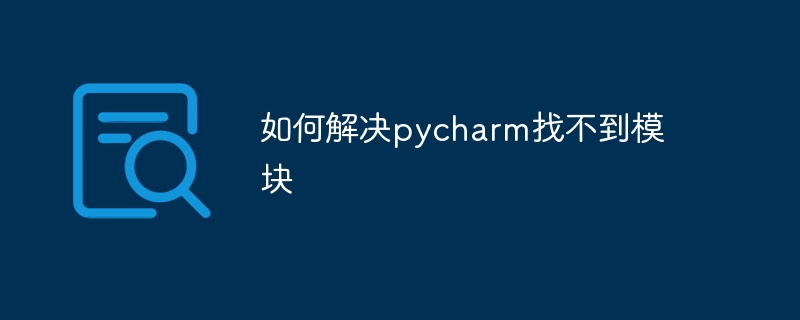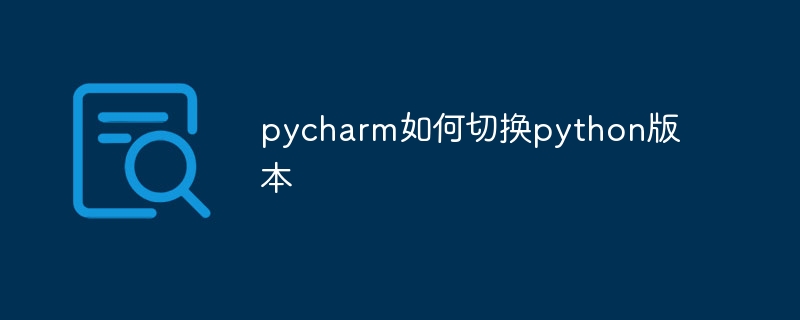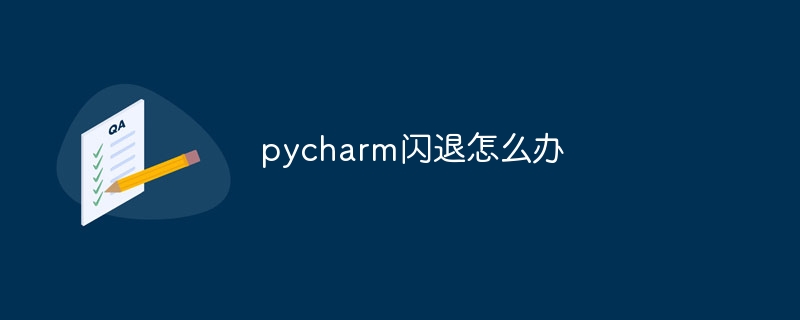 Backend Development
Backend Development Python Tutorial
Python Tutorial PyCharm Tips: Elegantly Handle Code Automatically Wrapping Problems
PyCharm Tips: Elegantly Handle Code Automatically Wrapping Problems
PyCharm Tips: Handle the code automatic line wrapping problem gracefully
In the process of using PyCharm for Python programming, we often encounter the code automatic line wrapping problem, especially when When a line of code is too long, automatic line wrapping may affect the readability and aesthetics of the code. How to deal with this problem gracefully and make the code cleaner and more readable? This article will introduce some techniques for dealing with code automatic line wrapping in PyCharm, and demonstrate it through specific code examples.
1. Use backslash()
In Python, you can use backslash() to indicate the continuity of code, that is, to split a line of code into multiple lines but logically Still one line. In PyCharm, when a line of code is too long, you can automatically wrap it by adding a backslash. Here is an example:
result = 10 + 20 +
30 + 40 +
50
print(result)In this example, a long addition operation is divided into multiple lines, each line ending with a backslash. This not only makes it easier to read, but also keeps the code clean.
2. Use parentheses (( ))
In Python, you can use parentheses to wrap a long line of code to achieve automatic line wrapping. In PyCharm, when entering a long expression within parentheses, you can press the Enter key to automatically split the code into multiple lines. An example is as follows:
result = (10 + 20 + 30 +
40 + 50)
print(result)By using brackets, we can split the code into multiple lines more intuitively and improve the readability of the code.
3. Set the code style of PyCharm
PyCharm also provides a wealth of code style setting options, which can adjust the display method of code according to personal preferences and project needs, including automatic line wrapping. set up. Find the Code Style setting in PyCharm's settings, where you can customize the display style of the code by adjusting parameters, including code indentation, line width, line breaks, etc.
Conclusion
Through the above methods, we can elegantly handle the code automatic line wrapping problem in PyCharm, making the code clearer and easier to read. In the actual programming process, choosing an appropriate way to handle code automatic line wrapping based on personal habits and project needs can improve code writing efficiency and maintainability.
I hope the content introduced in this article will be helpful to everyone! If you have more questions about PyCharm or Python programming, please leave a message to discuss.
The above is the detailed content of PyCharm Tips: Elegantly Handle Code Automatically Wrapping Problems. For more information, please follow other related articles on the PHP Chinese website!
 如何解决pycharm找不到模块Dec 04, 2023 pm 01:31 PM
如何解决pycharm找不到模块Dec 04, 2023 pm 01:31 PM解决pycharm找不到模块的方法:1、检查python解释器;2、安装缺失的模块;3、检查项目结构;4、检查系统路径;5、使用虚拟环境;6、重启PyCharm或电脑。PyCharm找不到模块是一个常见的问题,但通常可以通过一些步骤来解决,这个问题可能由多种原因引起,比如Python解释器配置不正确、模块没有正确安装或者PyCharm的项目设置有问题。
 pycharm打不开怎么办Dec 07, 2023 pm 05:09 PM
pycharm打不开怎么办Dec 07, 2023 pm 05:09 PMpycharm打不开可以通过检查系统要求、重新启动计算机、检查防病毒软件和防火墙设置、检查日志文件、更新PyCharm、检查系统环境变量、重置PyCharm设置、检查日志文件和报错信息、卸载并重新安装PyCharm和向PyCharm官方支持寻求帮助来解决。详细介绍:1、检查系统要求,确保计算机满足PyCharm的最低系统要求;2、重新启动计算机等等。
 pycharm怎么批量替换Dec 07, 2023 pm 05:27 PM
pycharm怎么批量替换Dec 07, 2023 pm 05:27 PMpycharm可以通过使用搜索和替换功能、结合正则表达式进行高级替换、使用代码重构功能、使用Structural Search and Replace和导入外部工具进行批量替换来批量替换。详细介绍:1、使用搜索和替换功能,打开PyCharm,打开要进行批量替换的项目或文件夹等等。
 pycharm注释快捷键有哪些Dec 05, 2023 pm 02:14 PM
pycharm注释快捷键有哪些Dec 05, 2023 pm 02:14 PMpycharm注释快捷键有:1、单行注释,使用“#”;2、多行注释,使用三引号“””;3、批量注释,选择要注释的文本行,背景变化后,同时按“Ctrl+/”;4、取消批量注释,选择已注释的文本行,背景变化后,同时按“Ctrl+/”;5、批量缩进,选择要缩进的文本行,背景变化后,按下“TAB”键;6、取消批量缩进,选择要缩进的文本行,背景变化后,按下“SHIFT+TAB”键。
 pycharm怎样改变背景颜色Dec 07, 2023 pm 04:58 PM
pycharm怎样改变背景颜色Dec 07, 2023 pm 04:58 PMpycharm改变背景颜色的方法:1、使用主题设置,在PyCharm设置对话框中,选择 "Editor",选择喜欢的主题,点击 "Apply"即可;2、使用自定义背景颜色,在 "Editor"选项卡中,点击"Background",选择喜欢的颜色,确认即可;3、使用快捷键快速更改背景颜色,按下 "Ctrl+Alt+S" 组合键打开设置对话框,跟上面一样选择型号的颜色即可等等。
 pycharm和python有什么区别Dec 04, 2023 pm 04:26 PM
pycharm和python有什么区别Dec 04, 2023 pm 04:26 PMpycharm和python区别是:1、PyCharm是一款软件开发工具,而Python则是一种编程语言;2、PyCharm提供了丰富的功能和工具,而Python本身提供了各种库和模块;3、PyCharm主要用于编写、调试和运行Python代码,而Python语言可以应用于各种开发场景等等。
 pycharm如何切换python版本Dec 08, 2023 pm 02:14 PM
pycharm如何切换python版本Dec 08, 2023 pm 02:14 PMpycharm切换python版本的方法:1、通过项目配置,在“New Project”或“Open”对话框中,可以指定Python解释器的版本;2、使用虚拟环境,虚拟环境为每个项目提供了一个隔离的Python环境,可以在不影响其他项目的情况下更改和升级库和依赖项;3、使用系统环境变量,可以添加一个新的系统环境变量,指向使用的Python解释器的路径;4、使用第三方插件等等。
 pycharm闪退怎么办Dec 08, 2023 pm 02:03 PM
pycharm闪退怎么办Dec 08, 2023 pm 02:03 PMpycharm闪退可以通过检查系统要求、升级PyCharm版本、检查插件、检查日志文件、检查Java环境、重置PyCharm配置、检查操作系统更新、启动时清除缓存和重新安装PyCharm解决。详细介绍:1、检查系统要求,确保计算机满足PyCharm的系统要求;2、升级PyCharm版本,官方会不断修复和改进软件,新版本可能会修复一些已知的问题;3、检查插件等等。


Hot AI Tools

Undresser.AI Undress
AI-powered app for creating realistic nude photos

AI Clothes Remover
Online AI tool for removing clothes from photos.

Undress AI Tool
Undress images for free

Clothoff.io
AI clothes remover

AI Hentai Generator
Generate AI Hentai for free.

Hot Article

Hot Tools

SublimeText3 Chinese version
Chinese version, very easy to use

mPDF
mPDF is a PHP library that can generate PDF files from UTF-8 encoded HTML. The original author, Ian Back, wrote mPDF to output PDF files "on the fly" from his website and handle different languages. It is slower than original scripts like HTML2FPDF and produces larger files when using Unicode fonts, but supports CSS styles etc. and has a lot of enhancements. Supports almost all languages, including RTL (Arabic and Hebrew) and CJK (Chinese, Japanese and Korean). Supports nested block-level elements (such as P, DIV),

SublimeText3 Linux new version
SublimeText3 Linux latest version

MantisBT
Mantis is an easy-to-deploy web-based defect tracking tool designed to aid in product defect tracking. It requires PHP, MySQL and a web server. Check out our demo and hosting services.

SAP NetWeaver Server Adapter for Eclipse
Integrate Eclipse with SAP NetWeaver application server.






